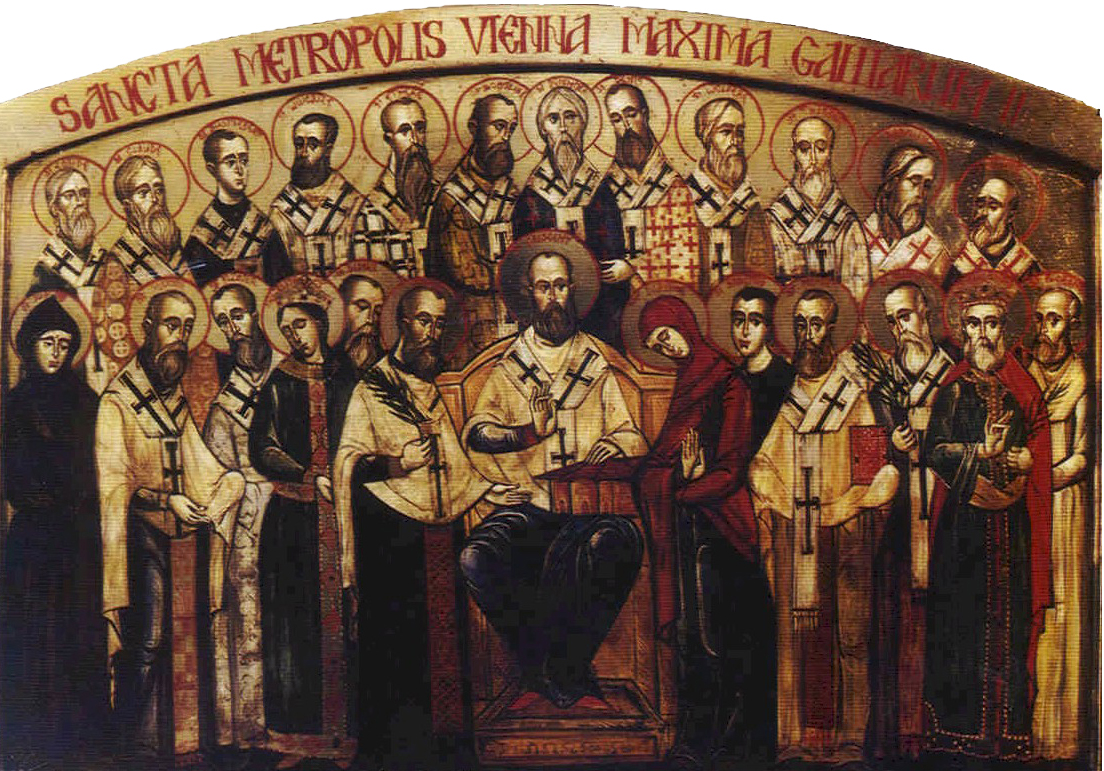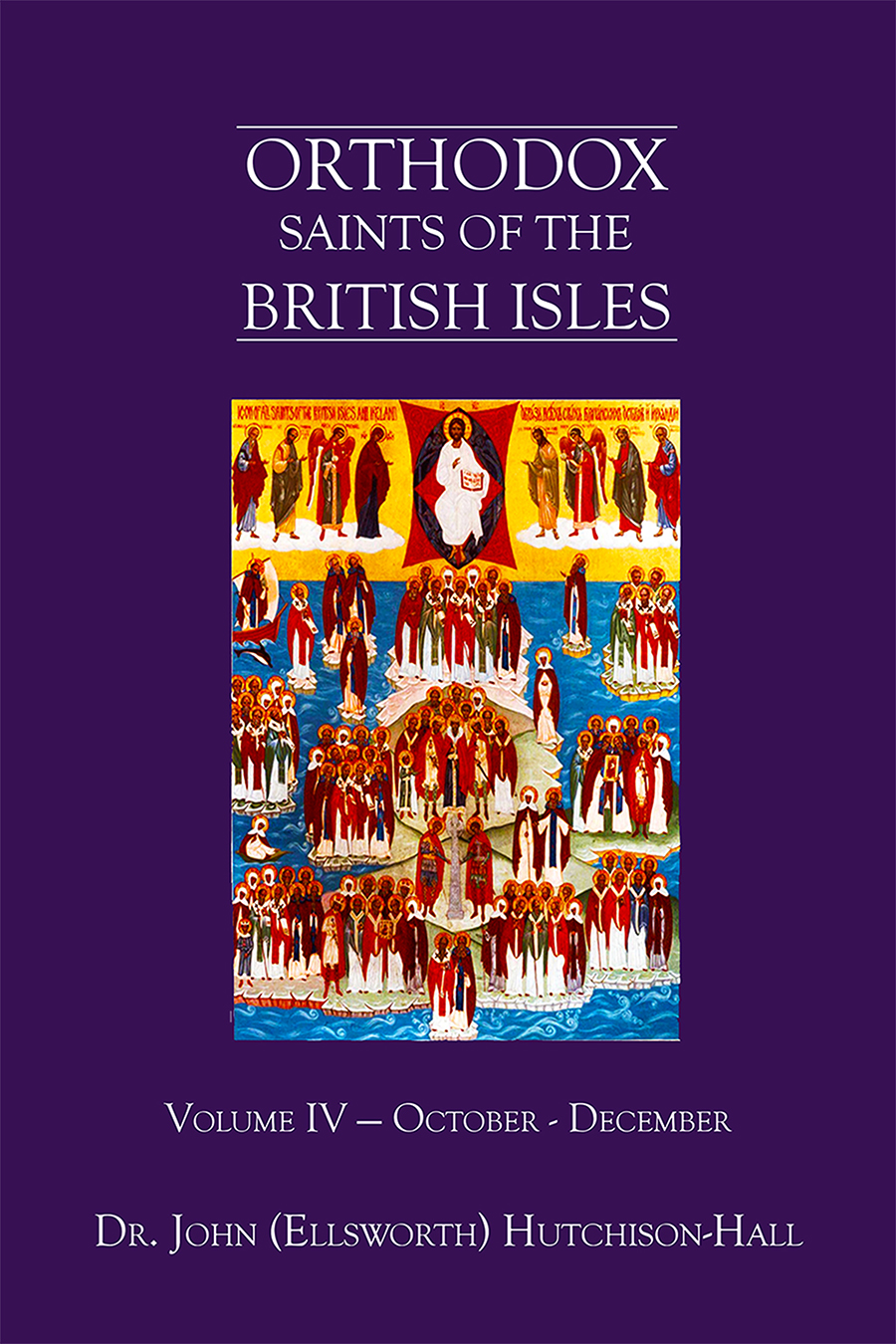
Orthodox Saints of the Pre-Schism
See of Rome
23rd October (NS) — 10th October (OS) 2024
ALDERICUS (ALDRIC, AUDRI) of SENS, after receiving monastic tonsure at the Abbey of SS. Peter and Paul of Ferrières (l'abbaye Saint-Pierre-et-Saint-Paul de Ferrières), in the Centre-Val de Loire region of present-day north-central France, St. Aldericus served as a priest in the Archdiocese of Sens (north-central France). He later served as Chancellor of the Archdiocese of Sens before being consecrated its Archbishop in 828. St. Aldericus reposed in 841.
CASSIUS and FLORENTIUS the MARTYR, (Late Third Century), according to tradition SS. Cassius and Florentius were members of the Theban Legion (22nd September) who were beheaded at Bonn (North Rhine-Westphalia) for the faith. The Bonn Minster (Bonner Münster), originally the collegiate church of SS. Cassius and Florentius, is situated at the spot where they are believed to have been martyred. SS. Cassius and Florentius are the patron saints of Bonn.
CERBONIUS of VERONA, a Bishop of Verona (northern Italy) prior to 400, nothing certain is known of his life.
CERBONIUS of POPULONIA, a priest from North Africa who, like most of his fellow Christians, fled the Arian Vandals. St. Cerbonius settled in Populonia in Tuscany (central Italy). There he became known for his holiness of life and was chosen to serve as Bishop of Populonia circa 544. He later was exiled to the Island of Elba (off the coast of Tuscany) for having hidden Roman soldiers from the invading Ostrogoths. St. Cerbonius spent the rest of his life as a hermit on Elba, reposing in 575. He was buried at Populonia, however his relics were later translated to Massa Marittima in southern Tuscany and enshrined in the Cathedral of St. Cerbonius.
CLARUS of NANTES, (Third Century), a missionary to Brittany (north-western France), who served as the first Bishop of Nantes (Upper Brittany). According to some traditions, St. Clarus was a disciple of the Apostle Peter (29th June).
FULK, the twenty-first Abbot the Abbey of St. Wandrille (abbaye Saint-Wandrille) in Fontenelle, Normandy (north-western France). St. Fulk reposed in 845.
GEREON, (Late Third Century), believed to have been an officer in the Theban Legion (22nd September), and member of the same detachment as SS. Cassius and Florentius (vide supra), martyred in or near Cologne in the present-day German state of North Rhine-Westphalia. St. Gereon's Basilica in Cologne commemorates him.
PATRICIAN, (Fifth Century), a bishop of an unknown See in Scotland. Forced to flee his See by heathen invaders, St. Patrician spent the rest of his life in exile on the Isle of Man. Nothing further is known of his life.
PAULINUS of CAPUA, a pilgrim, most likely British, who, while staying in Capua (near Naples in southern Italy), was selected to be their bishop by the local population, albeit against his will. Acquiescing, St. Paulinus served that See as a model prelate for eight years, unitl his repose in 843.
PAULINUS of YORK, a native of Rome, St. Paulinus, along with SS. Mellitus of Canterbury (24th April) and Justus of Canterbury (10th November), was sent England by Pope St. Gregory the Dialogist (3rd September) to reinforce St. Augustine of Canterbury’s (27th May) mission. St. Bede the Venerable (25th May) writes in his Historia ecclesiastica, that when St. Ethelburga of Kent (8th September), married King St. Edwin of Northumbria (12th October), St. Paulinus was consecrated the first Bishop of York, and accompanied St. Ethelburga to her new home. Once in Northumbria, St. Paulinus, with the assistance of St. Ethelburga, converted King St. Edwin and was instrumental in the conversion of Northumbria. Following King St. Edwin’s martyrdom in 633, St. Ethelburga returned to Kent accompanied by St. Paulinus, who was then made Bishop of Rochester, serving that See until his repose in 644.
TANCA, a young woman from Troyes (north-central France), who was martyred circa 637 while defending her virtue.
VICTOR of XANTEN and COMPANIONS, (Late Third Century), a group of three hundred and thirty soldiers of the Theban Legion (22nd September) who were martyred at Agaunum (present-day Saint-Maurice, Switzerland). In the 12th century, St. Victor's relics were translated to the Cathedral of St. Victor (St.-Viktor-Dom) in Xanten, in the present-day German state of North Rhine-Westphalia. No further information on these martyrs is extant.
Get your copy of Orthodox Saints of the British Isles today.
Available at Amazon or your favourite e-bookstore.
AMO (AMON) of TOUL, nothing is known about St. Amo except for his name and that he was the second Bishop of Toul (north-eastern France) from circa 375, until his repose circa 400–425.
BENEDICT of SEBASTE, although St. Benedict is traditionally believed to have been a Bishop of Sebaste in the Holy Land, though the pre-eminent hagiographic scholars of the Société des Bollandistes (the Bollandists), have questioned this, additionally St. Benedict is not listed as a bishop in commemorations of the Roman Catholic Church. St. Benedict is said to have been forced to flee his See of Sebaste by Emperor Julian the Apostate (r. 361–363) and was given refuge by St. Hilary of Poitiers (13th January). St. Hilary gave him land near Poitiers (west-central France) on which to build a hermitage, which later became the Abbey of St. Benedict (Abbaye Saint-Benoît de Quinçay) at Quinçay north-west of Poitiers. St. Benedict reposed circa 654.
CLETHER (CLEER, CLYDOG, SCLEDOG, CLITANUS, CLEODIUS), what we know of St. Clether's life is mainly based upon pious tradition. It is believed he was a descendant of King St. Brychan of Brycheiniog (6th April), and is said to have been a disciple of St. Brynach of Carn-Engyle (7th April). There are several churches in Cornwall, and the civil parish and village of St. Cleer also in Cornwall which commemorate him. The village of Clodock in Herefordshire is also named for him. St. Clether is thought to have reposed circa 520. The Moscow Patriarchate’s calendar commemorates him on 4th November as St. Clether, hermit of Cornwall.
DOMITIUS of AMIENS, an eighth century priest or deacon in the Diocese of Amiens (northern France) who lived as a hermit. According to some, St. Domitius was the Spiritual Father of St. Ulphia of Amiens (31st January).
ELFLEDA (ÆLFLEAD), this St. Elfleda was an Anglo-Saxon princess who lived as an anchoress at Glastonbury Abbey (Somerset, England). She was greatly admired by St. Dunstan of Canterbury (19th May), to whom she prophesied the year and day of her repose, which took place in the mid-tenth century. She is not to be confused with the following St. Elfleda, her contemporary and namesake, who was Abbess of Romsey.
ETHELFLEDA (ELFLEDA), the existence of several St. Elfledas and the paucity of available information, which is muddled at best, makes it difficult to provide accurate information on the life of this saint. From Baring-Gould we learn that this St. Ethelfleda is believed to have been the daughter of Æthelwald of Wessex, who was killed in battle soon after her birth. St. Ethelfleda was sent to Romsey Abbey (Hampshire, England) at an early age to be educated. In time St. Ethelfleda received monastic tonsure, and soon came to be known for the sanctity of her life and feats of asceticism. It is related that once, when St. Ethelfleda was reading the Lesson at Matins, the wind kept extinguishing her candle, so she held her hand up and light streamed forth, providing the necessary illumination for her. She was also known for chanting Psalms whilst standing naked in the nearby River Test at night. St. Ethelfleda served as Abbess of Romsey for the last few years of her life, reposing in the late tenth century.
JOHN of SYRACUSE, Bishop of Syracuse in Sicily from 595 until his repose circa 609.
ODA of AQUITAINE, a Frankish princess and widow of the Duke of Aquitaine (south-western France). Following the repose of her husband, St. Oda dedicated her life and wealth to the care of the poor and suffering. She reposed circa 723, her shrine is in Amay, near Liege in present-day Belgium.
ROMANUS of ROUEN, a courtier to King Chlotar II (r. 613–629) who was consecrated the twentieth Bishop of Rouen (Normandy north-western France) circa 629. During the decade or so of his episcopacy, St. Romanus, worked to eradicate the last vestiges of paganism in his See. A wonderworker, St Romanus also devoted much of his time to caring for prisoners, especially those with capital sentences. St. Romanus reposed in 639.
SERVANDUS of CADIZ and GERMANUS of CADIZ (MARTYRS of CADIZ), brothers who lived in Cadiz (south-western Spain). SS. Servandus and Germanus were martyred during the Diocletianic Persecution (303–313).
SEVERINUS (SEURIN) of BORDEAUX, often confused with his contemporary and native of Bordeaux (south-western France), St. Severinus of Cologne (vide infra). This St. Severinus was "from the East" according to St. Gregory of Tours (17th November) and served as the fourth Bishop of Bordeaux from circa 405 until his repose in 420. He is remembered for his wonderworking, and fierce opposition to Arianism.
SEVERINUS BOETHIUS, the statesman, philosopher, and martyr, Anicius Manlius Torquatus Severinus Boethius was a member of a Roman Consular family. St. Severinus served as a Consul, as did his father and sons, and later he also was an aide and advisor to Theodoric the Great, King of the Ostrogoths (r. 475–526). Though the author of several theological treatises, St. Severinus is best remembered for his more secular works, especially the De Consolatione Philosophiæ. About the year 534 political rivals accused him of disloyalty to the throne, and republican leanings, St. Severinus was gaoled, and without trial Theodoric ordered that he be put to death. Though there is no documentary evidence to support it, St. Severinus has always been considered a martyr, with a very strong cultus around Pavia in Lombardy (northern Italy) where his execution took place. St. Severinus' relics are enshrined in the Cathedral of Santo Stefano e di Santa Maria del Popolo in Pavia, Italy.
SEVERINUS of COLOGNE, a native of Bordeaux (south-western France) often confused with his namesake and contemporary St. Severinus of Bordeaux (vide supra). St. Severinus was the third (circa 348–403) reliably documented Bishop of Cologne in the present-day German state of North Rhine-Westphalia. The little that is known of him is conflated with the life of St. Severinus of Bordeaux, though his ardent stance against Arianism is well documented. St. Severinus reposed circa 403.
SYRE (SYRA) of FAREMOUTIERS, a spiritual daughter of St. Burgundofara (3rd April) at the Abbey of Our Lady of Faremoutiers (abbaye Notre-Dame de Faremoutiers), in Faremoutiers (north-central France). St. Syre was later chosen to be abbess of an abbey at Châlons-sur-Marne (present-day Châlons-en-Champagne, Marne, in north-eastern France). St. Syre reposed circa 660.
VERUS of SALERNO, (Fourth Century), a wonderworker, St. Verus was the third Bishop of Salerno (south-western Italy. He is remembered for his zealous defence of orthodox Christianity.
Prior to the Schism the Patriarchate of Rome was Orthodox, and fully in communion with the Orthodox Church. As Saint John of Shanghai and San Francisco +1966 said “The West was Orthodox for a thousand years, and her venerable Liturgy is far older than any of her heresies”.
Details of British Saints excerpted from Orthodox Saints of the British Isles.
Details of continental saints from these sources.
In many cases there are several spelling versions of the names of saints from the British Isles. I use the Oxford Dictionary of National Biography version as the primary version with the more prevalent version in parenthesis e.g. Ceadda (Chad) of Lichfield.

